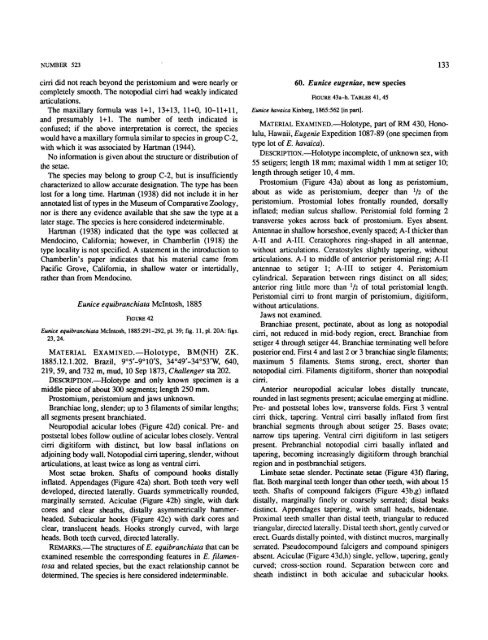A Review of the Genus Eunice - Smithsonian Institution Libraries
A Review of the Genus Eunice - Smithsonian Institution Libraries
A Review of the Genus Eunice - Smithsonian Institution Libraries
You also want an ePaper? Increase the reach of your titles
YUMPU automatically turns print PDFs into web optimized ePapers that Google loves.
NUMBER 523 133<br />
cirri did not reach beyond <strong>the</strong> peristomium and were nearly or<br />
completely smooth. The notopodial cirri had weakly indicated<br />
articulations.<br />
The maxillary formula was 1+1, 13+13, 11+0, 10-11+11,<br />
and presumably 1+1. The number <strong>of</strong> teeth indicated is<br />
confused; if <strong>the</strong> above interpretation is correct, <strong>the</strong> species<br />
would have a maxillary formula similar to species in group C-2,<br />
with which it was associated by Hartman (1944).<br />
No information is given about <strong>the</strong> structure or distribution <strong>of</strong><br />
<strong>the</strong> setae.<br />
The species may belong to group C-2, but is insufficiently<br />
characterized to allow accurate designation. The type has been<br />
lost for a long time. Hartman (1938) did not include it in her<br />
annotated list <strong>of</strong> types in <strong>the</strong> Museum <strong>of</strong> Comparative Zoology,<br />
nor is <strong>the</strong>re any evidence available that she saw <strong>the</strong> type at a<br />
later stage. The species is here considered indeterminable.<br />
Hartman (1938) indicated that <strong>the</strong> type was collected at<br />
Mendocino, California; however, in Chamberlin (1918) <strong>the</strong><br />
type locality is not specified. A statement in <strong>the</strong> introduction to<br />
Chamberlin's paper indicates that his material came from<br />
Pacific Grove, California, in shallow water or intertidally,<br />
ra<strong>the</strong>r than from Mendocino.<br />
<strong>Eunice</strong> equibranchiata Mclntosh, 1885<br />
FIGURE 42<br />
<strong>Eunice</strong> equibranchiata Mclntosh, 1885:291-292, pi. 39; fig. 11, pi. 20A: figs.<br />
23,24.<br />
MATERIAL EXAMINED.—Holotype, BM(NH) ZK.<br />
1885.12.1.202. Brazil, 9°5'-9°10'S, 34°49'-34°53'W, 640,<br />
219, 59, and 732 m, mud, 10 Sep 1873, Challenger sta 202.<br />
DESCRIPTION.—Holotype and only known specimen is a<br />
middle piece <strong>of</strong> about 300 segments; length 250 mm.<br />
Prostomium, peristomium and jaws unknown.<br />
Branchiae long, slender; up to 3 filaments <strong>of</strong> similar lengths;<br />
all segments present branchiated.<br />
Neuropodial acicular lobes (Figure 42d) conical. Pre- and<br />
postsetal lobes follow outline <strong>of</strong> acicular lobes closely. Ventral<br />
cirri digitiform with distinct, but low basal inflations on<br />
adjoining body wall. Notopodial cirri tapering, slender, without<br />
articulations, at least twice as long as ventral cirri.<br />
Most setae broken. Shafts <strong>of</strong> compound hooks distally<br />
inflated. Appendages (Figure 42a) short. Both teeth very well<br />
developed, directed laterally. Guards symmetrically rounded,<br />
marginally serrated. Aciculae (Figure 42b) single, with dark<br />
cores and clear sheaths, distally asymmetrically hammerheaded.<br />
Subacicular hooks (Figure 42c) with dark cores and<br />
clear, translucent heads. Hooks strongly curved, with large<br />
heads. Both teeth curved, directed laterally.<br />
REMARKS.—The structures <strong>of</strong> E. equibranchiata that can be<br />
examined resemble <strong>the</strong> corresponding features in E. filamentosa<br />
and related species, but <strong>the</strong> exact relationship cannot be<br />
determined. The species is here considered indeterminable.<br />
60. <strong>Eunice</strong> eugeniae, new species<br />
FIGURE 43a-h. TABLES 41, 45<br />
<strong>Eunice</strong> havaica Kinbcrg, 1865:562 [in part].<br />
MATERIAL EXAMINED.—Holotype, part <strong>of</strong> RM 430, Honolulu,<br />
Hawaii, Eugenie Expedition 1087-89 (one specimen from<br />
type lot <strong>of</strong> E. havaica).<br />
DESCRIPTION.—Holotype incomplete, <strong>of</strong> unknown sex, with<br />
55 setigers; length 18 mm; maximal width 1 mm at setiger 10;<br />
length through setiger 10,4 mm.<br />
Prostomium (Figure 43a) about as long as peristomium,<br />
about as wide as peristomium, deeper than V2 <strong>of</strong> <strong>the</strong><br />
peristomium. Prostomial lobes frontally rounded, dorsally<br />
inflated; median sulcus shallow. Peristomial fold forming 2<br />
transverse yokes across back <strong>of</strong> prostomium. Eyes absent.<br />
Antennae in shallow horseshoe, evenly spaced; A-I thicker than<br />
A-II and A-I 11. Ceratophores ring-shaped in all antennae,<br />
without articulations. Ceratostyles slightly tapering, without<br />
articulations. A-I to middle <strong>of</strong> anterior peristomial ring; A-II<br />
antennae to setiger 1; A-I 11 to setiger 4. Peristomium<br />
cylindrical. Separation between rings distinct on all sides;<br />
anterior ring little more than x /i <strong>of</strong> total peristomial length.<br />
Peristomial cirri to front margin <strong>of</strong> peristomium, digitiform,<br />
without articulations.<br />
Jaws not examined.<br />
Branchiae present, pectinate, about as long as notopodial<br />
cirri, not reduced in mid-body region, erect. Branchiae from<br />
setiger 4 through setiger 44. Branchiae terminating well before<br />
posterior end. First 4 and last 2 or 3 branchiae single filaments;<br />
maximum 5 filaments. Stems strong, erect, shorter than<br />
notopodial cirri. Filaments digitiform, shorter than notopodial<br />
cirri.<br />
Anterior neuropodial acicular lobes distally truncate,<br />
rounded in last segments present; aciculae emerging at midline.<br />
Pre- and postsetal lobes low, transverse folds. First 3 ventral<br />
cirri thick, tapering. Ventral cirri basally inflated from first<br />
branchial segments through about setiger 25. Bases ovate;<br />
narrow tips tapering. Ventral cirri digitiform in last setigers<br />
present. Prebranchial notopodial cirri basally inflated and<br />
tapering, becoming increasingly digitiform through branchial<br />
region and in postbranchial setigers.<br />
Limbate setae slender. Pectinate setae (Figure 430 flaring,<br />
flat. Both marginal teeth longer than o<strong>the</strong>r teeth, with about 15<br />
teeth. Shafts <strong>of</strong> compound falcigers (Figure 43b,g) inflated<br />
distally, marginally finely or coarsely serrated; distal beaks<br />
distinct Appendages tapering, with small heads, bidentate.<br />
Proximal teeth smaller than distal teeth, triangular to reduced<br />
triangular, directed laterally. Distal teeth short, gently curved or<br />
erect. Guards distally pointed, with distinct mucros, marginally<br />
serrated. Pseudocompound falcigers and compound spinigers<br />
absent. Aciculae (Figure 43d,h) single, yellow, tapering, gently<br />
curved; cross-section round. Separation between core and<br />
sheath indistinct in both aciculae and subacicular hooks.
















